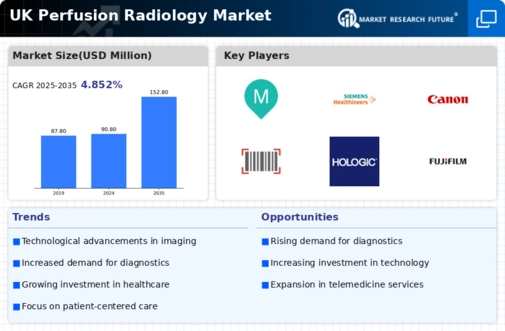Rising Demand for Non-Invasive Procedures
The increasing preference for non-invasive diagnostic techniques is driving the perfusion radiology market. Patients and healthcare providers are gravitating towards methods that minimize discomfort and recovery time. Non-invasive imaging techniques, such as perfusion MRI and CT perfusion, are gaining traction due to their ability to provide detailed insights into blood flow and tissue perfusion without the need for surgical intervention. This shift is reflected in the growing number of procedures performed annually, with estimates suggesting a rise of approximately 15% in non-invasive imaging utilization in the UK. As healthcare systems prioritize patient-centric approaches, the demand for non-invasive options in the perfusion radiology market is expected to continue its upward trajectory.
Growing Awareness of Cardiovascular Diseases
The rising prevalence of cardiovascular diseases in the UK is a significant driver for the perfusion radiology market. With conditions such as heart attacks and strokes becoming increasingly common, there is a heightened awareness among both healthcare professionals and the public regarding the importance of early detection and intervention. This awareness is leading to an increase in the utilization of perfusion imaging techniques, which are crucial for assessing blood flow and identifying areas of ischemia. Data suggests that cardiovascular diseases account for nearly 30% of all deaths in the UK, underscoring the urgent need for effective diagnostic tools. Consequently, the demand for perfusion radiology services is expected to grow as healthcare providers seek to improve diagnostic accuracy and patient management.
Aging Population and Increased Diagnostic Needs
The aging population in the UK is contributing to the rising demand for diagnostic imaging services. As individuals age, the likelihood of developing chronic conditions, including cardiovascular diseases, increases, necessitating regular monitoring and assessment. The Office for National Statistics indicates that the proportion of individuals aged 65 and over is projected to rise to 23% by 2030. This demographic shift is expected to drive the demand for advanced imaging techniques that can provide critical insights into perfusion and vascular health. Consequently, healthcare providers are likely to invest more in perfusion radiology services to meet the growing diagnostic needs of an aging population.
Technological Integration in Healthcare Systems
The integration of advanced technologies into healthcare systems is transforming the landscape of the perfusion radiology market. The adoption of electronic health records (EHR) and telemedicine is facilitating better data sharing and collaboration among healthcare providers. This technological synergy allows for more efficient patient management and streamlined workflows, which are essential for timely perfusion imaging. Furthermore, the incorporation of artificial intelligence (AI) in imaging analysis is enhancing diagnostic accuracy and reducing interpretation time. As healthcare facilities in the UK continue to embrace these technological advancements, the perfusion radiology market is likely to experience growth driven by improved operational efficiencies and enhanced patient care.
Increased Investment in Healthcare Infrastructure
The UK government has been making substantial investments in healthcare infrastructure, which is positively impacting the perfusion radiology market. Enhanced funding for hospitals and diagnostic centers is facilitating the acquisition of advanced imaging technologies. Reports indicate that the UK healthcare budget has seen an increase of around £20 billion over the past few years, aimed at improving diagnostic capabilities. This financial support enables healthcare facilities to upgrade their imaging equipment, thereby enhancing the quality and efficiency of perfusion studies. As a result, the perfusion radiology market is likely to benefit from improved access to state-of-the-art technologies, ultimately leading to better patient outcomes.






















Leave a Comment